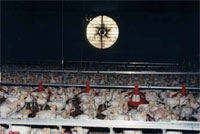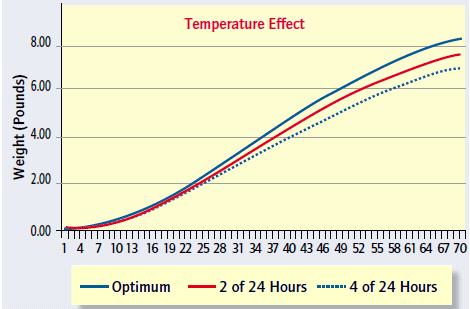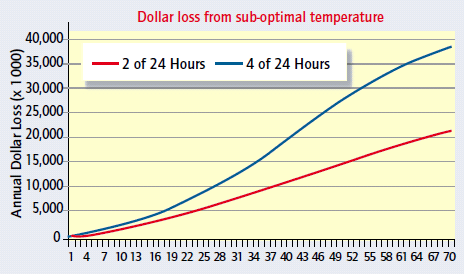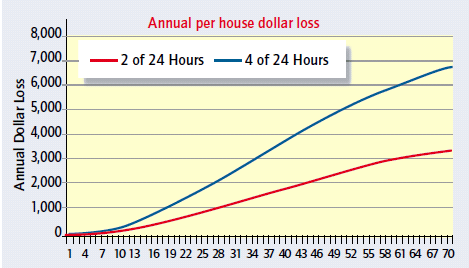



The Economic Importance of Poultry Ventilation Management
By John R. Blakely, technical manager for Aviagen in the eastern USA, and Dr Gene Simpson of the Agricultural Economics Faculty at Auburn University in the USA. Poor ventilation will affect broiler growth and economic output. The authors focus on the importance of variation in the house environment on broiler performance.The amount of time required for broilers to reach a given target weight has been considerably reduced due to improvements in genetics, nutrition and management. At the same time, processing bodyweight requirements have become more precise in response to market demand.
Although these two factors would seem to promote a simpler route to an improved final product, producing a target weight broiler in a reduced amount of time can present a challenge to the grower. For example, flock weight differences of 115g (0.25lb) and 230g (0.50lb) are commonly seen at target weights of 1815g (4.00lb) and 3405g (7.50lb), respectively. These deviations in flock weight occur even though the same genetics and feed source are being used within a production complex, significantly affecting economic output. So why do these differences in target weight occur?

Variation in the in-house environment, which is largely influenced by ventilation, significantly affects broiler performance. The grower is responsible for managing ventilation.
Growth Rate and Income
A common way to compare growth rates between flocks of differing ages is to calculate the average daily gain (ADG), which is simply the average bodyweight divided by the age (in days) at processing. Comparing these figures reveals differences between growers. For example, in a small bird complex, some flocks will achieve an ADG of 45g (0.10lb), while others will achieve 50g (0.11lb) per day. The difference in these figures means that one grower will send broilers to the processing plant achieving an average bodyweight at 39 days of 1770g (3.90lb), while the second producer will process birds weighing an average of 1950g (4.29lb). For the first producer to equal the second, four days of additional growth would be needed.
Differences in growth rates typically experienced in heavier broilers are also significant. For example, in one flock, broilers being grown to 3180g (7.00lb) may achieve an ADG of 50g (0.11lb), while another flock may achieve an ADG of 59g (0.13lb). If both flocks are processed at 60 days, one flock would weigh an average of 2995g (6.60lb) per bird, while the other flock would average 3540g (7.80lb). At these growth rates, the first flock would have to be grown to 70 days to equal the final average weight of the second flock - a difference in processing age of 10 days.
* "Seemingly small differences in growth rate can have large effects on overall productivity" |
In reality, the flocks are usually processed at very similar ages. When this occurs, allowing “additional days” for slower-growing flocks to “catch up” is not practised. Growers with broiler flocks experiencing poorer weight gains will receive significantly less income. In addition, the contracting company will make significantly less profit. As these examples illustrate, seemingly small differences in growth rate can have large effects on overall productivity.
Ventilation Effects on Growth and Feed Conversion
Changes in the modern broiler have increased the importance of in-house environmental factors. In response to market requirements, geneticists have raised not only growth rate, but also the yield of carcass components. The extra meat yield in these birds, most of which is concentrated in the breast, makes the broiler more sensitive to high temperatures; therefore, much of the difference in performance of these birds can be attributed to how well the grower manages environmental temperature.
Broiler genetic lines have been selected for growth rate, most of which is determined by their desire to eat. If temperatures are too high, broilers will not eat as much as they could, or may not eat at all. Managing in-house conditions is largely a function of optimising the ventilation programme, which can be done by evaluating grower ventilation management and subsequent bird performance.
If the ventilation (temperature) is not ideal for any part of a day, the potential growth for that part of the day is lost and can NEVER be regained.
For example, a 38-day broiler has 912 hours of time to grow. If growth rate deviates from the 1815g (4.0lb) target by 115g (0.25lb), or 6.3%, this means that for 6.3% of the time, or 57 hours, the broiler did not grow as well as it could have. Most likely, this decreased growth resulted from numerous periods of several hours at a time, during which conditions were not ideal.
In addition to decreasing growth rate, temperature problems can also affect performance by elevating feed conversion (FCR). If ventilation problems result in cooler than ideal temperatures, broilers will still eat sufficiently and will grow; however, proportionately more of the energy consumed will go towards maintaining normal body temperature instead of towards growth. In this case, although weight gain will be on target, the cost of production is higher because of the elevated FCR. Cooler than desirable temperatures, even for a few hours, increase feed requirements and result in poorer performance.
Effects on Cost and Income
In affecting the broiler’s performance by lowering growth rate and raising FCR, ventilation problems greatly affect production cost. Therefore, the consequences of improper ventilation are that the grower and the company lose money.



Improper ventilation for any amount of time has an adverse effect on broiler performance (Figure 1). The blue line is the expected weight of flocks grown under ‘ideal conditions’. The red line shows the expected weight of flocks grown under conditions that are too hot for two hours per day. The dotted line shows the expected weight of flocks grown under conditions too hot for four hours per day.
From the data in this illustration, for a 38-day-old bird, the difference in expected weight between optimum environmental conditions and higher temperatures for 2 of 24 hours is 160g (0.35lb) and the difference between optimum environmental conditions and higher temperatures 4 of 24 hours is 320g (0.70lb). That represents, for example, 4762kg (10,500lb) of lost weight potential where the optimum ventilation is not maintained for 2 of 24 hours, for a single house of 30,000 birds.
Figure 2 illustrates the company’s loss of income for less than optimum performance. If it is assumed that one million birds per week are processed, with 75% carcass yield and a wholesale price of $1.56/kg ($0.71/lb), at 38 days of age, the losses are $9.7 million and $19.4 million, for 2 of 24 hours and 4 of 24 hours, respectively. At older flock ages, these losses will be higher. Based on this information, assuming that only 10% of broiler flocks placed within a company experiences these “non-optimal” conditions, the losses are still significant.
Figure 3 indicates age-related economic losses in one house for less than optimum performance. Using this information with 20,000 birds per flock placement, five flocks per year, and a grower payment of $0.11/kg ($0.05/lb); with the live weights achieved at 38 days, $1,750 and $3,500 of income would be lost for 2 of 24 hours and 4 of 24 hours, respectively. At older flock ages, these economic losses will further increase.
Conclusions
Modern houses equipped with technologies to enable the management of static pressure controlled ventilation inlets, tunnel ventilation and evaporative cooling can work extremely well. However, the producer must properly manage and maintain the ventilation equipment. Otherwise, bodyweight and/or feed conversion can be impaired, resulting in significant financial loss to the grower and integrator.
Clearly, proper ventilation and in-house environmental management programmes are essential to minimising flock weight differences and maximising profit for both the grower and integrator.
This article was first published in World Poultry magazine earlier this year.
September 2008









